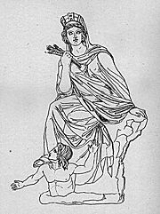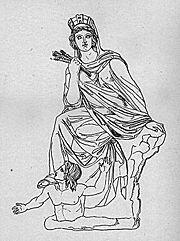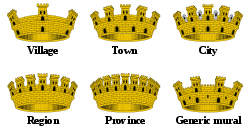
Mural crown
Encyclopedia
Usage in ancient times

Tyche
In ancient Greek city cults, Tyche was the presiding tutelary deity that governed the fortune and prosperity of a city, its destiny....
, the embodiment of the fortune of a city, familiar to Romans as Fortuna
Fortuna
Fortuna can mean:*Fortuna, the Roman goddess of luck -Geographical:*19 Fortuna, asteroid*Fortuna, California, town located on the north coast of California*Fortuna, United States Virgin Islands...
. The high cylindrical polos
Polos
Polos generally refers to a high cylindrical crown typically worn by mythological goddesses.Polos may also refer to:* The plural of polo* In music, the polos is one of the interlocking parts of Kotekan...
of Cybele
Cybele
Cybele , was a Phrygian form of the Earth Mother or Great Mother. As with Greek Gaia , her Minoan equivalent Rhea and some aspects of Demeter, Cybele embodies the fertile Earth...
too could be rendered as a mural crown in Hellenistic times, specifically designating the Mother Goddess as patron of a city.
The mural crown became an ancient Roman
Roman Republic
The Roman Republic was the period of the ancient Roman civilization where the government operated as a republic. It began with the overthrow of the Roman monarchy, traditionally dated around 508 BC, and its replacement by a government headed by two consuls, elected annually by the citizens and...
military decoration
Military decoration
A military decoration is a decoration given to military personnel or units for heroism in battle or distinguished service. They are designed to be worn on military uniform....
. The Roman
Ancient Rome
Ancient Rome was a thriving civilization that grew on the Italian Peninsula as early as the 8th century BC. Located along the Mediterranean Sea and centered on the city of Rome, it expanded to one of the largest empires in the ancient world....
corona muralis (Latin
Latin
Latin is an Italic language originally spoken in Latium and Ancient Rome. It, along with most European languages, is a descendant of the ancient Proto-Indo-European language. Although it is considered a dead language, a number of scholars and members of the Christian clergy speak it fluently, and...
: "walled crown") was a gold
Gold
Gold is a chemical element with the symbol Au and an atomic number of 79. Gold is a dense, soft, shiny, malleable and ductile metal. Pure gold has a bright yellow color and luster traditionally considered attractive, which it maintains without oxidizing in air or water. Chemically, gold is a...
en crown, or a circle of gold intended to resemble a battlement
Battlement
A battlement in defensive architecture, such as that of city walls or castles, comprises a parapet , in which portions have been cut out at intervals to allow the discharge of arrows or other missiles. These cut-out portions form crenels...
, bestowed upon the soldier
Soldier
A soldier is a member of the land component of national armed forces; whereas a soldier hired for service in a foreign army would be termed a mercenary...
who first climbed the wall of a besieged city
City
A city is a relatively large and permanent settlement. Although there is no agreement on how a city is distinguished from a town within general English language meanings, many cities have a particular administrative, legal, or historical status based on local law.For example, in the U.S...
or fortress to successfully place the standard
Flag
A flag is a piece of fabric with a distinctive design that is usually rectangular and used as a symbol, as a signaling device, or decoration. The term flag is also used to refer to the graphic design employed by a flag, or to its depiction in another medium.The first flags were used to assist...
of the attacking army
Army
An army An army An army (from Latin arma "arms, weapons" via Old French armée, "armed" (feminine), in the broadest sense, is the land-based military of a nation or state. It may also include other branches of the military such as the air force via means of aviation corps...
upon it. The Roman mural crown was made of gold, and decorated with turrets, as is the heraldic version. As it was among the highest order of military decorations, it was not awarded to a claimant until after a strict investigation. The rostrata
Rostrata
Rostratus , Rostrata or Rostratum is a Latin adjective meaning "beaked, curved, hooked, with a crooked point, or with a curved front"...
mural crown, composed of the rostra
Rostra
The Rōstra was a large platform built in the city of Rome that stood during the republican and imperial periods. Speakers would stand on the rostra and face the north side of the comitium towards the senate house and deliver orations to those assembled in between...
indicative of captured ships, was assigned as naval prize to the first in a boarding party, similar to the naval crown
Naval crown
The Naval Crown was a gold crown surmounted with the prows of ships. It was a Roman military award, given to the first man who boarded an enemy ship during a naval engagement....
.
The Graeco-Roman goddess Roma
Roma (mythology)
In traditional Roman religion, Roma was a female deity who personifed the city of Rome and more broadly, the Roman state. Her image appears on the base of the column of Antoninus Pius.-Problems in earliest attestation:...
's attributes on Greek coinage usually include her mural crown, signifying Rome's status as a loyal protector of Hellenic city-states.
Heraldry

Heraldry
Heraldry is the profession, study, or art of creating, granting, and blazoning arms and ruling on questions of rank or protocol, as exercised by an officer of arms. Heraldry comes from Anglo-Norman herald, from the Germanic compound harja-waldaz, "army commander"...
, where the term is used to denote a crown
Crown (headgear)
A crown is the traditional symbolic form of headgear worn by a monarch or by a deity, for whom the crown traditionally represents power, legitimacy, immortality, righteousness, victory, triumph, resurrection, honour and glory of life after death. In art, the crown may be shown being offered to...
modeled after the walls of a castle
Castle
A castle is a type of fortified structure built in Europe and the Middle East during the Middle Ages by European nobility. Scholars debate the scope of the word castle, but usually consider it to be the private fortified residence of a lord or noble...
, which may be tinctured or, argent, gules, or proper, i.e. stone-coloured. In Germany, during the 19th century mural crowns (Mauerkronen) came to be adopted for the arms of cities, with increasingly specific details: "Residential (i.e. having a royal residence
Residenz
Residenz is a very formal, otherwise obsolete, German word for "place of living". It is in particular used to denote the building or town where a sovereign ruler resided, therefore also carrying a similar meaning as the modern expressions seat of government or capital...
) cities and capital towns usually bear a Mauerkrone with five towers, large towns one with four towers, smaller towns one with three", observed Arthur Charles Fox-Davies
Arthur Charles Fox-Davies
Arthur Charles Fox-Davies was a British author on heraldry. By profession, he was a barrister but he also worked as a journalist and novelist.Born in Bristol, he was the second son of T...
, in A Complete Guide to Heraldry, adding "Strict regulations in the matter do not yet exist" and warning that the usage was not British. Similarly, in recent times, mural crowns used, rather than royal crowns, for Italian medieval
Medieval commune
Medieval communes in the European Middle Ages had sworn allegiances of mutual defense among the citizens of a town or city. They took many forms, and varied widely in organization and makeup. Communes are first recorded in the late 11th and early 12th centuries, thereafter becoming a widespread...
and modern commune
Comune
In Italy, the comune is the basic administrative division, and may be properly approximated in casual speech by the English word township or municipality.-Importance and function:...
s. A mural-crowned lady, Italia Turrita
Italia Turrita
Italia Turrita is the national personification or allegory of Italy, characterised by a mural crown typical of Italian civic heraldry of communal origin.. In broader terms, the crown symbolizes its mostly urban history.Italia Turrita is a woman with typical Mediterranean attributes...
, is a symbol of Italy
Italy
Italy , officially the Italian Republic languages]] under the European Charter for Regional or Minority Languages. In each of these, Italy's official name is as follows:;;;;;;;;), is a unitary parliamentary republic in South-Central Europe. To the north it borders France, Switzerland, Austria and...
. In Italy, communes and some provinces and military corps have a mural crown on their coat of arms, golden and with five towers for cities, silver and nine-towered for the others; also use it. The coat of arms
Coat of arms
A coat of arms is a unique heraldic design on a shield or escutcheon or on a surcoat or tabard used to cover and protect armour and to identify the wearer. Thus the term is often stated as "coat-armour", because it was anciently displayed on the front of a coat of cloth...
of the Second Spanish Republic
Second Spanish Republic
The Second Spanish Republic was the government of Spain between April 14 1931, and its destruction by a military rebellion, led by General Francisco Franco....
had a mural crown. Most Portuguese
Portugal
Portugal , officially the Portuguese Republic is a country situated in southwestern Europe on the Iberian Peninsula. Portugal is the westernmost country of Europe, and is bordered by the Atlantic Ocean to the West and South and by Spain to the North and East. The Atlantic archipelagos of the...
(and Brazil
Brazil
Brazil , officially the Federative Republic of Brazil , is the largest country in South America. It is the world's fifth largest country, both by geographical area and by population with over 192 million people...
ian) municipal coats of arms contain a mural crown, with three towers in modern usage signifying a village, four towers representing a town, and five towers standing for a city. Similarly, the Romania
Romania
Romania is a country located at the crossroads of Central and Southeastern Europe, on the Lower Danube, within and outside the Carpathian arch, bordering on the Black Sea...
n municipal coats of arms contain a mural crown, with one or three towers for villages and communes, five and seven towers for towns and municipalities.
After the dissolution of the Austro-Hungarian Empire at the end of World War I
World War I
World War I , which was predominantly called the World War or the Great War from its occurrence until 1939, and the First World War or World War I thereafter, was a major war centred in Europe that began on 28 July 1914 and lasted until 11 November 1918...
, the single-headed eagle
Coat of arms of Austria
The current coat of arms of Austria, albeit without the broken chains, has been in use by the Republic of Austria since 1919. Between 1934 and the German annexation in 1938 Austria used a different coat of arms, which consisted of a double-headed eagle...
of the coat of arms
Coat of arms
A coat of arms is a unique heraldic design on a shield or escutcheon or on a surcoat or tabard used to cover and protect armour and to identify the wearer. Thus the term is often stated as "coat-armour", because it was anciently displayed on the front of a coat of cloth...
of Republic of Austria
Austria
Austria , officially the Republic of Austria , is a landlocked country of roughly 8.4 million people in Central Europe. It is bordered by the Czech Republic and Germany to the north, Slovakia and Hungary to the east, Slovenia and Italy to the south, and Switzerland and Liechtenstein to the...
began to wear a mural crown in the place of the former royal Austrian and Hungarian crown
Hungarian Crown
The Hungarian Crown was a part of the Polish Crown Jewels. It was made in the 16th century, resembling the Crown of Saint Stephen, as a private crown of John II Sigismund Zápolya.- History :...
s that adorned the double-headed eagle
Double-headed eagle
The double-headed eagle is a common symbol in heraldry and vexillology. It is most commonly associated with the Byzantine Empire and the Holy Roman Empire. In Byzantine heraldry, the heads represent the dual sovereignty of the Emperor and/or dominance of the Byzantine Emperors over both East and...
of former coat of arms.
See also
- Naval crownNaval crownThe Naval Crown was a gold crown surmounted with the prows of ships. It was a Roman military award, given to the first man who boarded an enemy ship during a naval engagement....
- Grass CrownGrass CrownThe Grass Crown or Blockade Crown was the highest and rarest of all military decorations in the Roman Republic and early Roman empire. It was presented only to a general, commander, or officer whose actions saved the legion or the entire army...
- Civic CrownCivic CrownThe Civic Crown was a chaplet of common oak leaves woven to form a crown. During the Roman Republic, and the subsequent Principate, it was regarded as the second highest military decoration to which a citizen could aspire...
- Emblem of Italy
- Laurel wreathLaurel wreathA laurel wreath is a circular wreath made of interlocking branches and leaves of the bay laurel , an aromatic broadleaf evergreen. In Greek mythology, Apollo is represented wearing a laurel wreath on his head...
- Italia TurritaItalia TurritaItalia Turrita is the national personification or allegory of Italy, characterised by a mural crown typical of Italian civic heraldry of communal origin.. In broader terms, the crown symbolizes its mostly urban history.Italia Turrita is a woman with typical Mediterranean attributes...
- National personificationNational personificationA national personification is an anthropomorphization of a nation or its people; it can appear in both editorial cartoons and propaganda.Some early personifications in the Western world tended to be national manifestations of the majestic wisdom and war goddess Minerva/Athena, and often took the...
- The Stella d’ItaliaThe Stella d’ItaliaThe Stella d’Italia is the most ancient identity symbol of the Italian land. In modern times it has been associated with the Italia Turrita , the ancient allegorical representation of the Italian peninsula....

